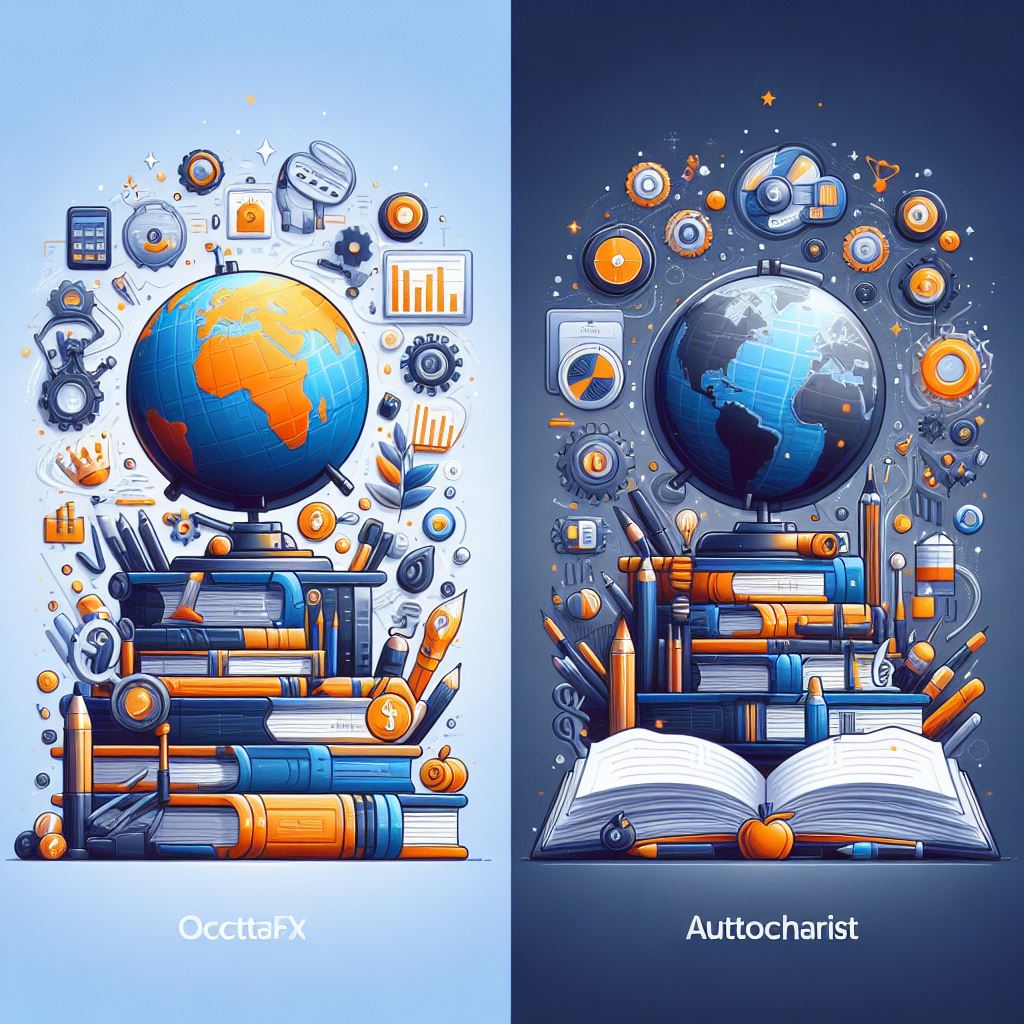AutoChartist and OctaFX are two popular platforms for Forex and CFD trading, but they have some key differences that traders should understand. AutoChartist vs OctaFX Comparison

This comprehensive guide compares the two across various factors to help you determine which is better suited for your needs.
Overview and Key Info (AutoChartist vs OctaFX Comparison)
| AutoChartist | OctaFX | |
|---|---|---|
| Description | Auto-chart analysis service integrated with brokers to scan markets and identify trade opportunities | Global Forex broker offering currency pairs, commodities, cryptocurrencies, stocks & indices |
| Year Founded | 2004 | 2011 |
| Headquarters | Australia | St. Vincent and the Grenadines |
| Regulated By | NA | VFSC (St. Vincent) |
| Platforms | Web, iOS, Android | MT4/MT5 (desktop, web, mobile) |
| Account Types | NA | Micro, Standard, ECN |
| Tradeable Assets | Forex and CFDs | 55+ Currency Pairs, Cryptos, Commodities, Equities |
| Spreads | NA | Floating (from 0 pips) / Fixed / ECN |
| Leverage | NA | Up to 1:500 |
| Commissions | NA | No commission (floating/fixed spreads) / $2-$7 per lot (ECN) |
AutoChartist provides automated technical analysis of currency pairs to identify potential trade opportunities, which it conveys to brokers. It does not function as a broker itself. OctaFX, on the other hand, is an established retail Forex/CFD broker offering trading accounts and access to global markets.
Chart Pattern Recognition
One of AutoChartist’s key features is its pattern recognition technology, which scans currency charts across 28 Forex pairs to identify over 30 chart patterns. Once a pattern is identified, the details are relayed in real-time to brokers using the AutoChartist service.
OctaFX does not currently offer automated chart pattern recognition or trade signals. You would need to manually analyze charts or utilize EA advisors/indicators in the platform.
Overall, AutoChartist specializes specifically in detecting chart patterns automatically to assist traders in spotting trading opportunities. OctaFX focuses more on providing traders the tools and environment to trade themselves.
Trading Platforms and Tools
OctaFX provides the popular MetaTrader 4 (MT4) and MetaTrader 5 (MT5) trading platforms. These are available across desktop, web, and mobile devices. You get access to charts, technical indicators, Expert Advisors (EAs), and more for analyzing markets and executing Forex orders.

There are also copy trading platforms available via MT4/MT5 in OctaFX, includingsignals and EAs from top traders. This allows you to automatically copy positions from seasoned Forex traders.
In comparison, AutoChartist does not have its own trading platform, as it purely provides analyzed signals/patterns directly to partner brokers’ platforms. The brokers offer the actual trading ability.
So OctaFX certainly provides a richer trading experience directly, while AutoChartist focuses exclusively on analytics/signals to assist with decision-making.
Account Types
OctaFX provides clients three main real trading account types to meet different trader requirements:
- Micro Account – For smaller deposits and lot sizes. Fast execution through market maker model. Fixed/variable spreads from 1 pip.
- Standard Account – For mid-sized deposits. Direct raw market access through Straight Through Processing (STP) model. Floating spreads from 0 pips.
- ECN Account – For larger deposits above $1,000. Direct interbank market access with top liquidity providers through ECN model. Floating spreads from 0 pips + commission fees.
The broker also offers a Demo Account with $10,000 virtual funds if you want to test the platform risk-free first.
Meanwhile, AutoChartist does not offer trading accounts directly since it simply plugs into supported broker platforms. The account type, spreads, leverage etc. depend on the brokers it integrates with.
Educational Resources
A standout aspect of OctaFX is the breadth of learning resources available beyond just a trading platform. These are helpful whether you’re new to Forex trading or a seasoned pro:
- eBooks – 5-Module Forex Trading Course plus micro books focused on specific strategies, analysis methods, money management, and psychology training.
- Webinars – Frequent training webinars diving deep into trading concepts and walkthroughs hosted by professional traders and the OctaFX team. Recordings also available.
- Blogs/News – Active Forex focused blogs and news sites like MasterYourFinance, providing the latest fundamental analyses, econ calendar events, technical strategies, and more.

In comparison, AutoChartist does not currently offer educational materials or trading analysis research. It is purely an automated technical analysis service.
OctaFX goes much further on trader education through its free eBooks, webinars, and active blogs. So newer traders would certainly benefit from these materials to develop their knowledge and skills over time.
Customer Support
OctaFX provides customer support 24 hours a day, 5 days a week via:
- Live Chat
- Phone
Support is available in over 20 languages, which is valuable for an international customer base.
AutoChartist does not list dedicated customer support options on its website since it doesn’t facilitate direct trading. Support would be provided by the brokers it links with instead.
Regulation and Safety
OctaFX holds regulation from the Vanuatu Financial Services Commission (VFSC) in St. Vincent and the Grenadines. They operate under the jurisdiction of VFSC standards for fair trading and security of client funds.
AutoChartist is not regulated itself as it offers market analytics services directly rather than brokerage services. However, many of the brokers it partners with would have certain regulatory oversight in their operating regions.
For those considering OctaFX, its VFSC regulation provides oversight and security for your trading funds and personal information held with the broker. AutoChartist would rely more on the brokers it channels services through.
Costs and Pricing
Using AutoChartist’s technical analysis services comes at no direct cost, as it charges brokerage partners rather than end user traders. Brokers typically pay monthly subscription fees to access AutoChartist’s scanning and signals inside their platforms.
OctaFX instead charges traders directly through:
- Spreads – Floating (from 0 pips) or fixed spreads starting from 1 pip. Tighter spreads available via ECN accounts.
- Commissions – $2-$7 commission per lot round turn charged only for ECN accounts.
- Financing Fees – Overnight swap rates applied for keeping trades open past market close.
There are no deposit, withdrawal, or inactivity fees otherwise. Compared to competitors, OctaFX offers very competitive spreads alongside zero extra fees, making costs reasonable for active traders on the platform.
| AutoChartist | OctaFX | |
|---|---|---|
| Direct Cost for Traders | $0 (Brokers pay fees) | Spreads +/- commissions (ECN only) |
| Spreads | NA | Floating spreads from 0 pips (ECN model) |
| Commissions | NA | $2-$7 per lot round turn (ECN accounts) |
| Non-Trading Fees | NA | No deposit/withdrawal/inactivity fees |
So traders essentially gain access to AutoChartist’s analytics directly via their broker’s pricing. But OctaFX provides a highly affordable trading environment itself under proper regulation.
Ease of Use
AutoChartist runs automated technical analysis in the backend, so there isn’t much complexity from a user perspective. Once signals are surfaced within a broker’s trading platform, you simply interpret and act on them accordingly.

The OctaFX MT4/MT5 platforms themselves have a slight learning curve if you’re unfamiliar. But overall, the user experience is very intuitive – you can open/manage positions with just a few clicks. The web and mobile apps also make accessing your account seamless.
Useful features for simplicity include:
- Integrated market research tools for analyzing potential trades
- Risk management tools for automatic position sizing
- Trade copying tools to mimic top traders’ portfolios
Both AutoChartist signals and OctaFX’s trading platforms are designed for simplicity and ease of use from a trader’s perspective. Performing technical analysis and executing orders is very straightforward.
Conclusion
AutoChartist specializes in automated technical analysis to identify trade opportunities and has integration across industry leading brokers. OctaFX focuses more on facilitating the trading environment directly with competitive pricing, platforms, and trader education.
AutoChartist would be more helpful for traders wanting an automated method of surfacingAnalyzer trades via chart pattern recognition. OctaFX provides robust trading ability from a regulated broker itself rather than purely signals.
Integrating AutoChartist alongside OctaFX’s web/mobile trading platforms would be a powerful combination – taking advantage of both automated analytics as well as efficient trade execution and portfolio management.
Overall though, due to its deep focus on trader learning resources and competitive fee structure, OctaFX emerges as the better solution for the majority of active Forex and CFD traders. Unless you specifically need automated pattern recognition or trade signals.
I hope this comprehensive comparison of AutoChartist vs OctaFX has been helpful! Let me know if you have any other questions or need any clarification in the comments.

